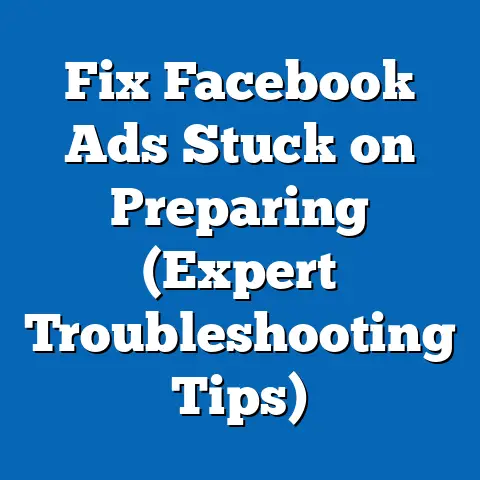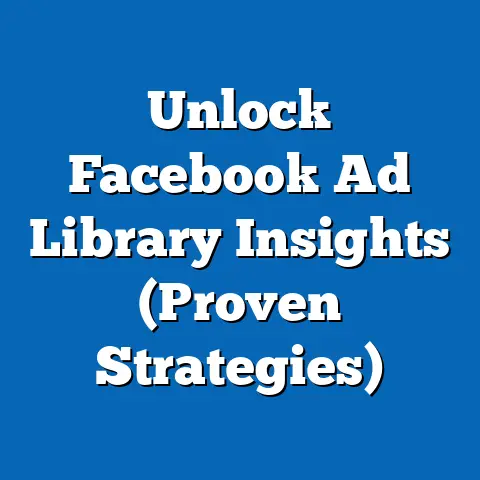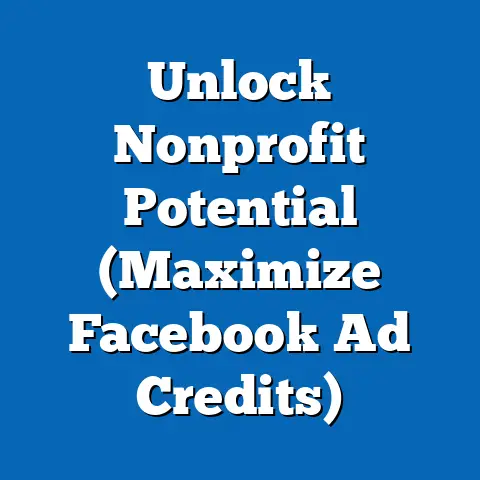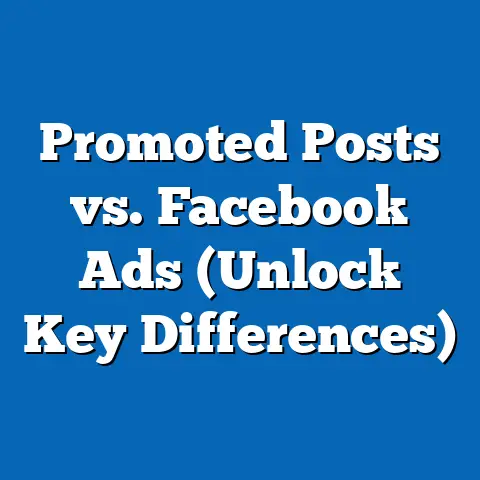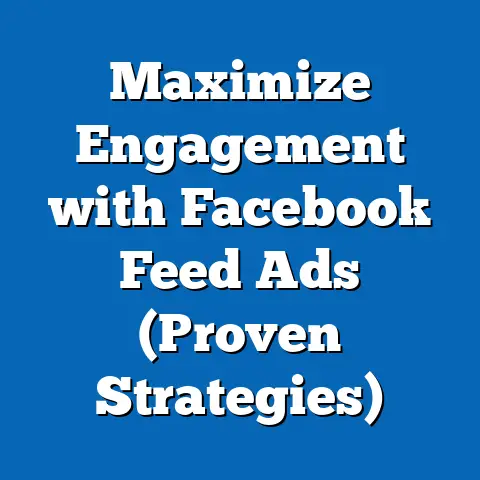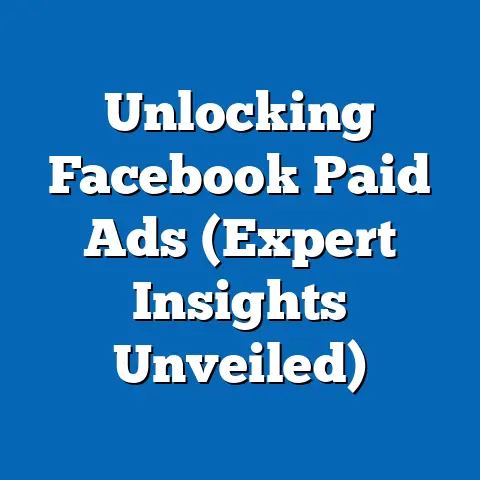Mastering Facebook Ads Account Management (Pro Tips Revealed)
Facebook advertising is a beast. A powerful, ever-changing beast. Over the years, I’ve witnessed firsthand how businesses can either thrive or crash and burn depending on how well they manage their Facebook Ads accounts. I remember working with a local bakery that had amazing products but no online presence. After setting up their Facebook Ads account and implementing a targeted campaign, they saw a 30% increase in foot traffic within the first month! But, I’ve also seen businesses waste thousands due to poor planning and a lack of understanding. That’s why mastering Facebook Ads account management is crucial, and I’m here to guide you through some pro tips that will set you on the path to success.
1. Understanding the Facebook Ads Ecosystem
Before diving into the nitty-gritty, it’s vital to grasp the fundamentals of the Facebook Ads ecosystem. It’s not just about throwing money at Facebook and hoping for the best. It’s a complex system with interconnected parts that all need to work in harmony.
- Overview of Facebook Ads and its Significance in Digital Marketing: Facebook Ads is a paid advertising platform that allows businesses to reach a massive audience on Facebook, Instagram, Messenger, and the Audience Network. With over 2.9 billion monthly active users on Facebook alone (as of early 2024), the potential reach is staggering. In today’s digital landscape, Facebook Ads is no longer optional – it’s a necessity for businesses looking to grow their brand awareness, generate leads, and drive sales.
-
Explanation of Different Ad Formats: Facebook offers a variety of ad formats to suit different objectives and creative styles. Here are a few key ones:
- Carousel Ads: These allow you to showcase multiple images or videos in a single ad, each with its own headline, description, and link. They are perfect for displaying multiple products or highlighting different features of a single product.
- Video Ads: These are highly engaging and can be used to tell a story, demonstrate a product, or simply capture attention. Short, impactful videos tend to perform best.
- Image Ads: These are the simplest format, consisting of a single image and accompanying text. They are ideal for quick, attention-grabbing messages.
- Collection Ads: These are designed for mobile shopping and allow users to browse and purchase products directly from the ad.
- Lead Ads: These allow you to collect leads directly from the ad without requiring users to leave Facebook. They are great for building your email list or gathering information for follow-up.
- Importance of Knowing Your Audience: One of the most powerful aspects of Facebook Ads is its targeting capabilities. You can target users based on demographics (age, gender, location), interests, behaviors, and connections. The more you know about your ideal customer, the more effectively you can target your ads and maximize your ROI.
Takeaway: Facebook Ads offers immense potential, but success depends on understanding the platform, ad formats, and the importance of targeted advertising.
Explanation of Different Ad Formats: Facebook offers a variety of ad formats to suit different objectives and creative styles. Here are a few key ones:
- Carousel Ads: These allow you to showcase multiple images or videos in a single ad, each with its own headline, description, and link. They are perfect for displaying multiple products or highlighting different features of a single product.
- Video Ads: These are highly engaging and can be used to tell a story, demonstrate a product, or simply capture attention. Short, impactful videos tend to perform best.
- Image Ads: These are the simplest format, consisting of a single image and accompanying text. They are ideal for quick, attention-grabbing messages.
- Collection Ads: These are designed for mobile shopping and allow users to browse and purchase products directly from the ad.
- Lead Ads: These allow you to collect leads directly from the ad without requiring users to leave Facebook. They are great for building your email list or gathering information for follow-up.
- Importance of Knowing Your Audience: One of the most powerful aspects of Facebook Ads is its targeting capabilities. You can target users based on demographics (age, gender, location), interests, behaviors, and connections. The more you know about your ideal customer, the more effectively you can target your ads and maximize your ROI.
Takeaway: Facebook Ads offers immense potential, but success depends on understanding the platform, ad formats, and the importance of targeted advertising.
2. Setting Up Your Facebook Ads Account for Success
A solid foundation is critical for any successful endeavor, and Facebook Ads is no exception. Setting up your account correctly from the start will save you headaches down the road.
-
Step-by-Step Guide on Creating a Facebook Ads Account:
- Create a Facebook Business Manager account: Go to business.facebook.com and create an account. This is your central hub for managing all your Facebook business assets.
- Add your Facebook Page: Connect your existing Facebook Page to your Business Manager account. If you don’t have a Page, create one.
- Create an Ad Account: Within Business Manager, navigate to “Ad Accounts” and create a new ad account. You’ll need to select a currency and time zone.
- Assign Roles: Give yourself and any team members access to the Ad Account with the appropriate roles (Admin, Advertiser, Analyst).
- Importance of Linking Your Facebook Business Manager and Instagram Accounts: Linking your accounts allows you to run ads on both platforms seamlessly and track performance across both channels. This is especially important if your target audience is active on Instagram.
- Setting Up Payment Methods and Understanding Billing Thresholds: Add a valid payment method (credit card, debit card, or PayPal) to your Ad Account. Facebook will bill you when you reach a certain spending threshold or at the end of each month, whichever comes first. Understanding your billing thresholds will help you avoid any unexpected charges.
Takeaway: Setting up your Facebook Ads account correctly involves creating a Business Manager, linking your Facebook Page and Instagram accounts, and configuring your payment settings.
Step-by-Step Guide on Creating a Facebook Ads Account:
- Create a Facebook Business Manager account: Go to business.facebook.com and create an account. This is your central hub for managing all your Facebook business assets.
- Add your Facebook Page: Connect your existing Facebook Page to your Business Manager account. If you don’t have a Page, create one.
- Create an Ad Account: Within Business Manager, navigate to “Ad Accounts” and create a new ad account. You’ll need to select a currency and time zone.
- Assign Roles: Give yourself and any team members access to the Ad Account with the appropriate roles (Admin, Advertiser, Analyst).
- Importance of Linking Your Facebook Business Manager and Instagram Accounts: Linking your accounts allows you to run ads on both platforms seamlessly and track performance across both channels. This is especially important if your target audience is active on Instagram.
- Setting Up Payment Methods and Understanding Billing Thresholds: Add a valid payment method (credit card, debit card, or PayPal) to your Ad Account. Facebook will bill you when you reach a certain spending threshold or at the end of each month, whichever comes first. Understanding your billing thresholds will help you avoid any unexpected charges.
Takeaway: Setting up your Facebook Ads account correctly involves creating a Business Manager, linking your Facebook Page and Instagram accounts, and configuring your payment settings.
3. Strategic Campaign Planning
“Failing to plan is planning to fail,” as the saying goes. Strategic campaign planning is the backbone of any successful Facebook Ads campaign.
-
How to Define Clear Objectives for Each Campaign: Before you start creating ads, ask yourself: “What do I want to achieve with this campaign?” Common objectives include:
- Awareness: Increasing brand visibility and reaching a wider audience.
- Consideration: Driving traffic to your website, generating leads, or encouraging engagement.
- Conversion: Driving sales, app installs, or other specific actions.
-
Identifying Key Performance Indicators (KPIs) to Measure Success: KPIs are the metrics you’ll use to track your progress towards your objectives. Examples include:
-
Click-Through Rate (CTR): The percentage of people who click on your ad after seeing it.
- Cost Per Click (CPC): The average cost you pay for each click on your ad.
- Return on Ad Spend (ROAS): The amount of revenue you generate for every dollar you spend on advertising.
- Importance of A/B Testing: A/B testing (also known as split testing) involves creating multiple versions of your ads and testing them against each other to see which performs best. This is crucial for optimizing your campaigns and maximizing your ROI. For example, you might test different headlines, images, or call-to-actions.
Takeaway: Strategic campaign planning involves defining clear objectives, identifying relevant KPIs, and implementing A/B testing to optimize your ads.
How to Define Clear Objectives for Each Campaign: Before you start creating ads, ask yourself: “What do I want to achieve with this campaign?” Common objectives include:
- Awareness: Increasing brand visibility and reaching a wider audience.
- Consideration: Driving traffic to your website, generating leads, or encouraging engagement.
- Conversion: Driving sales, app installs, or other specific actions.
-
Identifying Key Performance Indicators (KPIs) to Measure Success: KPIs are the metrics you’ll use to track your progress towards your objectives. Examples include:
-
Click-Through Rate (CTR): The percentage of people who click on your ad after seeing it.
- Cost Per Click (CPC): The average cost you pay for each click on your ad.
- Return on Ad Spend (ROAS): The amount of revenue you generate for every dollar you spend on advertising.
- Importance of A/B Testing: A/B testing (also known as split testing) involves creating multiple versions of your ads and testing them against each other to see which performs best. This is crucial for optimizing your campaigns and maximizing your ROI. For example, you might test different headlines, images, or call-to-actions.
Identifying Key Performance Indicators (KPIs) to Measure Success: KPIs are the metrics you’ll use to track your progress towards your objectives. Examples include:
Click-Through Rate (CTR): The percentage of people who click on your ad after seeing it.
Takeaway: Strategic campaign planning involves defining clear objectives, identifying relevant KPIs, and implementing A/B testing to optimize your ads.
4. Creating Compelling Ad Content
Your ad content is what will ultimately capture the attention of your target audience. It needs to be engaging, relevant, and persuasive.
-
Tips for Crafting Engaging Ad Copy:
- Know Your Audience: Speak their language and address their pain points.
- Highlight Benefits: Focus on what your product or service can do for them.
- Use Strong Verbs: Create a sense of urgency and excitement.
- Keep it Concise: People have short attention spans, so get to the point quickly.
- The Role of Visuals and Graphics: Visuals are just as important as the copy. Use high-quality images or videos that are relevant to your message and visually appealing. Consider using images that feature people, as these tend to be more engaging.
- Discussing the Importance of a Strong Call-to-Action (CTA): Your CTA tells people what you want them to do after seeing your ad. Use clear and concise CTAs such as “Shop Now,” “Learn More,” “Sign Up,” or “Contact Us.” Make sure your CTA is prominently displayed and easy to click.
Takeaway: Compelling ad content involves crafting engaging copy, using high-quality visuals, and including a strong call-to-action.
Tips for Crafting Engaging Ad Copy:
- Know Your Audience: Speak their language and address their pain points.
- Highlight Benefits: Focus on what your product or service can do for them.
- Use Strong Verbs: Create a sense of urgency and excitement.
- Keep it Concise: People have short attention spans, so get to the point quickly.
- The Role of Visuals and Graphics: Visuals are just as important as the copy. Use high-quality images or videos that are relevant to your message and visually appealing. Consider using images that feature people, as these tend to be more engaging.
- Discussing the Importance of a Strong Call-to-Action (CTA): Your CTA tells people what you want them to do after seeing your ad. Use clear and concise CTAs such as “Shop Now,” “Learn More,” “Sign Up,” or “Contact Us.” Make sure your CTA is prominently displayed and easy to click.
Takeaway: Compelling ad content involves crafting engaging copy, using high-quality visuals, and including a strong call-to-action.
5. Audience Targeting and Segmentation
Reaching the right people is essential for Facebook Ads success. Without effective targeting, you’re essentially shouting into the void.
-
In-Depth Analysis of Facebook Audience Targeting Options:
- Custom Audiences: These allow you to target people who have already interacted with your business, such as website visitors, email subscribers, or app users.
- Lookalike Audiences: These allow you to target people who are similar to your existing customers. Facebook uses its data to identify users who share similar demographics, interests, and behaviors with your customer base.
- Detailed Targeting: This allows you to target users based on demographics, interests, behaviors, and connections. You can narrow your audience by layering multiple targeting options.
- Strategies for Segmenting Your Audience: Segmentation involves dividing your audience into smaller groups based on specific characteristics. This allows you to deliver more personalized ad experiences. For example, you might segment your audience by age, gender, location, or interests.
- The Power of Retargeting: Retargeting is a powerful strategy for re-engaging users who have interacted with your brand but haven’t yet converted. You can retarget website visitors, people who have viewed your videos, or those who have added items to their cart but abandoned the purchase.
Takeaway: Effective audience targeting and segmentation involves using Custom Audiences, Lookalike Audiences, Detailed Targeting, and retargeting strategies to reach the right people with the right message.
In-Depth Analysis of Facebook Audience Targeting Options:
- Custom Audiences: These allow you to target people who have already interacted with your business, such as website visitors, email subscribers, or app users.
- Lookalike Audiences: These allow you to target people who are similar to your existing customers. Facebook uses its data to identify users who share similar demographics, interests, and behaviors with your customer base.
- Detailed Targeting: This allows you to target users based on demographics, interests, behaviors, and connections. You can narrow your audience by layering multiple targeting options.
- Strategies for Segmenting Your Audience: Segmentation involves dividing your audience into smaller groups based on specific characteristics. This allows you to deliver more personalized ad experiences. For example, you might segment your audience by age, gender, location, or interests.
- The Power of Retargeting: Retargeting is a powerful strategy for re-engaging users who have interacted with your brand but haven’t yet converted. You can retarget website visitors, people who have viewed your videos, or those who have added items to their cart but abandoned the purchase.
Takeaway: Effective audience targeting and segmentation involves using Custom Audiences, Lookalike Audiences, Detailed Targeting, and retargeting strategies to reach the right people with the right message.
6. Budgeting and Bidding Strategies
Managing your budget and bids effectively is crucial for maximizing your ROI. It’s a balancing act between reaching a large audience and keeping your costs under control.
-
Understanding the Different Budgeting Options:
- Daily Budget: This sets the average amount you’re willing to spend each day. Facebook may spend slightly more or less on any given day, but it will aim to stay within your daily budget over the course of a week.
- Lifetime Budget: This sets the total amount you’re willing to spend over the entire duration of your campaign. Facebook will optimize your spending to get the best results within your budget.
- How to Set Realistic Bids: Facebook uses an auction system to determine which ads to show to users. You can choose between automatic bidding (where Facebook sets your bids for you) or manual bidding (where you set your bids yourself). When starting, I recommend using automatic bidding to allow Facebook to learn and optimize your bids. Once you have enough data, you can switch to manual bidding to have more control over your costs.
-
Tips for Optimizing Your Budget:
-
Monitor Your Performance: Track your KPIs regularly and make adjustments to your budget as needed.
- Increase Your Budget Gradually: Avoid making drastic changes to your budget, as this can disrupt your campaign performance.
- Pause Underperforming Ads: Don’t be afraid to pause ads that aren’t performing well.
Takeaway: Budgeting and bidding strategies involve understanding your budgeting options, setting realistic bids, and optimizing your budget based on performance metrics.
Understanding the Different Budgeting Options:
- Daily Budget: This sets the average amount you’re willing to spend each day. Facebook may spend slightly more or less on any given day, but it will aim to stay within your daily budget over the course of a week.
- Lifetime Budget: This sets the total amount you’re willing to spend over the entire duration of your campaign. Facebook will optimize your spending to get the best results within your budget.
- How to Set Realistic Bids: Facebook uses an auction system to determine which ads to show to users. You can choose between automatic bidding (where Facebook sets your bids for you) or manual bidding (where you set your bids yourself). When starting, I recommend using automatic bidding to allow Facebook to learn and optimize your bids. Once you have enough data, you can switch to manual bidding to have more control over your costs.
-
Tips for Optimizing Your Budget:
-
Monitor Your Performance: Track your KPIs regularly and make adjustments to your budget as needed.
- Increase Your Budget Gradually: Avoid making drastic changes to your budget, as this can disrupt your campaign performance.
- Pause Underperforming Ads: Don’t be afraid to pause ads that aren’t performing well.
Tips for Optimizing Your Budget:
Monitor Your Performance: Track your KPIs regularly and make adjustments to your budget as needed.
Takeaway: Budgeting and bidding strategies involve understanding your budgeting options, setting realistic bids, and optimizing your budget based on performance metrics.
7. Monitoring and Analyzing Ad Performance
The journey doesn’t end after launching your campaign. In fact, that’s where the real work begins. Continuous monitoring and analysis are essential for identifying what’s working and what’s not.
- Overview of Facebook Ads Manager: The Facebook Ads Manager is your central hub for managing your campaigns. It provides a wealth of data and insights into your ad performance.
-
How to Read and Interpret Performance Metrics: Key metrics to track include:
- Impressions: The number of times your ad was shown.
- Reach: The number of unique people who saw your ad.
- Click-Through Rate (CTR): The percentage of people who clicked on your ad after seeing it.
- Cost Per Click (CPC): The average cost you pay for each click on your ad.
- Conversion Rate: The percentage of people who took the desired action after clicking on your ad (e.g., making a purchase, signing up for a newsletter).
- Return on Ad Spend (ROAS): The amount of revenue you generate for every dollar you spend on advertising.
- The Importance of Regular Performance Reviews: Set aside time each week (or even daily) to review your ad performance and make adjustments as needed. Look for trends and patterns in your data to identify areas for improvement.
Takeaway: Monitoring and analyzing ad performance involves using the Facebook Ads Manager, tracking key metrics, and conducting regular performance reviews.
How to Read and Interpret Performance Metrics: Key metrics to track include:
- Impressions: The number of times your ad was shown.
- Reach: The number of unique people who saw your ad.
- Click-Through Rate (CTR): The percentage of people who clicked on your ad after seeing it.
- Cost Per Click (CPC): The average cost you pay for each click on your ad.
- Conversion Rate: The percentage of people who took the desired action after clicking on your ad (e.g., making a purchase, signing up for a newsletter).
- Return on Ad Spend (ROAS): The amount of revenue you generate for every dollar you spend on advertising.
- The Importance of Regular Performance Reviews: Set aside time each week (or even daily) to review your ad performance and make adjustments as needed. Look for trends and patterns in your data to identify areas for improvement.
Takeaway: Monitoring and analyzing ad performance involves using the Facebook Ads Manager, tracking key metrics, and conducting regular performance reviews.
8. Scaling Successful Campaigns
Once you’ve identified a winning campaign, it’s time to scale it up and reach an even larger audience.
- Identifying High-Performing Ads: Look for ads that have a high CTR, low CPC, and a strong conversion rate. These are the ads you want to focus on scaling.
-
Techniques for Increasing Budget Allocation:
- Gradual Budget Increase: Increase your budget by 10-20% every few days to avoid disrupting your campaign performance.
- Duplicating Successful Campaigns: Create a duplicate of your winning campaign and target a new audience.
- Expanding Your Targeting: Broaden your targeting options to reach a larger audience.
-
Exploring Advanced Strategies:
-
Lookalike Audiences: Create lookalike audiences based on your existing customers to reach people who are similar to your best customers.
Techniques for Increasing Budget Allocation:
- Gradual Budget Increase: Increase your budget by 10-20% every few days to avoid disrupting your campaign performance.
- Duplicating Successful Campaigns: Create a duplicate of your winning campaign and target a new audience.
- Expanding Your Targeting: Broaden your targeting options to reach a larger audience.
-
Exploring Advanced Strategies:
-
Lookalike Audiences: Create lookalike audiences based on your existing customers to reach people who are similar to your best customers.
Lookalike Audiences: Create lookalike audiences based on your existing customers to reach people who are similar to your best customers.
9. Staying Updated with Facebook’s Ad Policies and Trends
Facebook’s advertising policies and algorithms are constantly evolving. Staying up-to-date is crucial for maintaining compliance and maximizing your results.
- Overview of Facebook’s Advertising Policies: Familiarize yourself with Facebook’s advertising policies to avoid having your ads disapproved or your account suspended. These policies cover a wide range of topics, including prohibited content, targeting restrictions, and ad formatting requirements.
- Keeping Up with the Latest Trends and Algorithm Changes: Follow industry blogs, attend webinars, and join Facebook Ads communities to stay informed about the latest trends and algorithm changes.
-
Resources and Tools to Stay Informed:
- Facebook Business Help Center: This is your go-to resource for information about Facebook Ads.
- Facebook Marketing Science: This blog publishes research and insights about Facebook advertising.
- Industry Blogs: Follow blogs like Social Media Examiner, HubSpot, and Neil Patel for the latest news and trends.
Takeaway: Staying updated with Facebook’s ad policies and trends involves familiarizing yourself with the policies, keeping up with the latest news, and utilizing available resources.
Resources and Tools to Stay Informed:
- Facebook Business Help Center: This is your go-to resource for information about Facebook Ads.
- Facebook Marketing Science: This blog publishes research and insights about Facebook advertising.
- Industry Blogs: Follow blogs like Social Media Examiner, HubSpot, and Neil Patel for the latest news and trends.
Takeaway: Staying updated with Facebook’s ad policies and trends involves familiarizing yourself with the policies, keeping up with the latest news, and utilizing available resources.
Conclusion: The Path to Mastery
Mastering Facebook Ads account management is a continuous journey of learning, testing, and adapting. It requires a deep understanding of the platform, a strategic mindset, and a willingness to experiment. By following these pro tips, you’ll be well on your way to achieving your advertising goals and driving real results for your business.
I remember when I first started with Facebook Ads, I felt completely overwhelmed. There was so much to learn, and the platform seemed to change every week. But with perseverance, dedication, and a willingness to learn from my mistakes, I was able to master the art of Facebook Ads account management. And now, I’m sharing my knowledge with you, so you can achieve the same success. Remember, the key is to stay curious, keep testing, and never stop learning. The digital landscape is constantly evolving, and the only way to stay ahead is to embrace change and adapt your strategies accordingly. So, go out there, experiment, and start mastering your Facebook Ads account management today!

